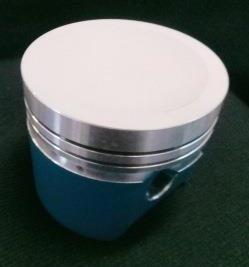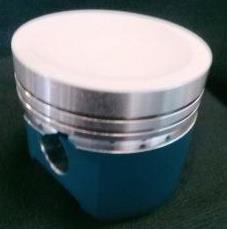Ceramic/Aluminium Coating
 Street & Race Coatings
Street & Race Coatings
LOST HEAT = LOST POWER
When performance really counts
|
Ceramic Exhaust Coatings Exhaust headers or factory castings can be coated both inside and outside. The process of producing extra horsepower is thought to work in the following manner. Because the exhaust temperature stays high the gas doesn’t undergo thermal contraction as it travels down the exhaust pipe. Exhaust velocity stays higher and results in better cylinder scavenging. Keeping the heat inside the exhaust pipe means that underbonnet temperatures are substantially reduced, so the engine breathes cooler (more dense) air which again boosts engine output. By coating the inside of the exhaust headers or manifold the gasses are provided with an exceptionally smooth surface to glide along. The improved laminar flow also keeps exhaust velocity high and along with the additional thermal barrier provides the performance advantage we’ve longed for. This unique coating system offers superior corrosion and fatigue/ oxidation protection at temperatures up to +800°C. Often mistaken for rust, thermal fatigue is a problem caused by cyclic temperatures and hot gas impingement. The Ceramic/Aluminium coating retards oxidation and heat buildup. In addition, self sacrificial quality of the coating continues to provide protection, even when nicked to the base metal, because it is electrochemically active. In accelerated salt-spray tests Ceramic/Aluminium coating lasts more than 140 times longer than high-temp paints, over 14 times longer than chrome. The combination is a non-brittle mixture that provides the best defence against corrosion, erosion, abrasion, discolouration, oxidation and thermal fatigue. Coating does not lead to hydrogen embrittlement. Also Available : Ceramic/Aluminium Extreme high temp. Black protection at temperatures up to +1200°C. For Turbo housings, Turbo pipes...... Thermal Barrier Coatings Thermal dispersant rapidly disperses heat away from coated component and evenly distributes heat over the coated surface. Coating aids in cooling heat sensitive parts and is excellent for superchargers, intercoolers, radiators, intake manifolds, brake components, oil pans etc. Good chemical and corrosion resistance. Semi gloss black finish. |
Thermal Barrier Coatings For Piston tops, Valve heads...........  Although effective on cast iron, this coating really comes into it’s own on aluminium heads. Coated combustion chambers make a substantial reduction in the heat load on the cooling system, this in turn leads to a cooler, more dense intake charge. There are two major advantages to coating the valves also. Firstly, although the inlet valve passes relatively cold fuel and air, it picks up as much, if not more, heat from combustion than the exhaust valve. The larger area of the inlet valve absorbs the combustion heat and promptly transfers some of this heat into the induction charge. Therefore the density of the charge is reduced and potential power is lost. Coated valves give an estimated reduction in heat pick-up of almost 70%. Secondly, the main reason exhaust valves have wider seats is because they must dissipate some of the tremendous heat energy picked up during combustion and whilst passing the exhaust gas. Too thin exhaust seats overheat and burn out. Coated valves offer a large temperature reduction, in many cases it would be feasible to run narrower seats to take advantage of the improved flow that, in many heads produces more power. Developed by MCCI (Metallic Ceramic Coatings, Inc.), for use on jet-fighter engines and submarine parts, Ceramic/Aluminium has been engineered to a third generation, tailored specifically for automotive applications. |
LFC Low Friction Coating For Piston skirts, Valve stems.......... LFC applied to piston skirts, valve stems and other components reduces friction between moving parts in extreme conditions. A co-efficient of friction as low as 0.019 (dry) is lower than steel on ice! Protection is even extended in the absence of oil, LFC has a load capacity of 150,000 psi. and the added ability to attract lubricant to the component. Ensuring that an oil film is always present, resulting in an increase in power and longer parts life through less friction. Piston skirts can be coated with LFC and piston crowns with Thermal Barrier Coating  Piston/bore clearance can be tailored to requirements in either .001", .002", or .003" thickness of coating. Valve stems can also be coated with LFC and the thermal barrier applied to the valve heads. Valve springs .......... Valve springs generate a considerable amount of heat as they coil and uncoil, thereby heating the surrounding oil. Valve spring failure is generally caused by high cam ramp speeds and compounded by inadequate cooling of the springs by the engine oil. By coating the valve spring, oil is better able to cling to these parts and assist in their cooling, thereby reducing the oil temperature as well. It is not uncommon for valve spring life to be doubled. Rocker shafts, cam followers and numerous other engine and driveline components can benefit from the treatment. |
Every effort has made to ensure the information in this newsletter is true and complete to the best of our knowledge. All recommendations are made without any guarantee on the part of the author, editor or publisher. Because the quality of most parts, materials and methods are beyond our control, we disclaim any liability incurred in connection with the use of this information.
© Hans Pedersen 1996